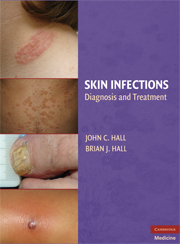Book contents
- Frontmatter
- Contents
- List of Contributors
- Acknowledgments
- INTRODUCTION
- TECHNIQUES IN DIAGNOSING DERMATOLOGIC MANIFESTATIONS OF INFECTIOUS DISEASES
- PRINCIPLES OF MANAGEMENT OF DERMATOLOGIC INFECTIONS IN THE SKIN
- PART 1 COMMON INFECTIONS
- PART II LESS COMMON INFECTIONS
- PART III INFECTIONS IN SELECTED ECOSYSTEMS
- PART IV INFECTIONS IN SELECTED PATIENT POPULATIONS
- PART V INFECTIONS OF SPECIFIC SKIN-ASSOCIATED BODY SITES
- 20 INFECTIONS OF THE SCALP
- 21 INFECTIONS OF THE NAIL UNIT
- 22 INFECTIONS OF THE MUCOUS MEMBRANES
- PART VI SPECIAL DISEASE CATEGORIES
- Index
20 - INFECTIONS OF THE SCALP
from PART V - INFECTIONS OF SPECIFIC SKIN-ASSOCIATED BODY SITES
Published online by Cambridge University Press: 08 January 2010
- Frontmatter
- Contents
- List of Contributors
- Acknowledgments
- INTRODUCTION
- TECHNIQUES IN DIAGNOSING DERMATOLOGIC MANIFESTATIONS OF INFECTIOUS DISEASES
- PRINCIPLES OF MANAGEMENT OF DERMATOLOGIC INFECTIONS IN THE SKIN
- PART 1 COMMON INFECTIONS
- PART II LESS COMMON INFECTIONS
- PART III INFECTIONS IN SELECTED ECOSYSTEMS
- PART IV INFECTIONS IN SELECTED PATIENT POPULATIONS
- PART V INFECTIONS OF SPECIFIC SKIN-ASSOCIATED BODY SITES
- 20 INFECTIONS OF THE SCALP
- 21 INFECTIONS OF THE NAIL UNIT
- 22 INFECTIONS OF THE MUCOUS MEMBRANES
- PART VI SPECIAL DISEASE CATEGORIES
- Index
Summary
INTRODUCTION
As an important component of skin, the hair-bearing scalp represents a unique microenvironment, which is afflicted by unique infections caused by many organisms such as fungi, viruses, parasites, and bacteria. Scalp infections affect all ages, both males and females and all races. This chapter describes the distinctive features of the hair-bearing scalp and its associated infections with highlights of current treatment regimes.
HISTORY
Scalp symptoms and conditions are common. Given the significance of scalp hair in today's society, visible changes in the hair and scalp such as erythema, scaling, and hair loss can cause considerable psychological distress and affect self-esteem. Although there are many causes of hair loss not associated with infections, infections of the scalp can lead to alopecia. Scalp infections are caused by various pathogenic organisms and were described years ago in Ancient Egypt.
SCALP ANATOMY
The scalp is comprised of five distinct layers: the skin, the subcutaneous layer, the galea aponeurosis, the loose areolar layer, and the periosteum. The frontalis and occipitalis muscles merge with the galea anteriorly and posteriorly respectively, and the temporalis muscle lies deeper under the loose areolar layer laterally. Important for scalp infections is the density of hair follicles and sebaceous glands (pilosebaceous units). In individuals without alopecia, the hair-bearing scalp contains approximately one hundred thousand (100, 000) hair follicles, which provide not only UV protection, but also considerable thermal insulation, creating an environment, which is warmer, darker, and more moist than in the nonhair-bearing parts of the body.
- Type
- Chapter
- Information
- Skin InfectionsDiagnosis and Treatment, pp. 255 - 267Publisher: Cambridge University PressPrint publication year: 2009



